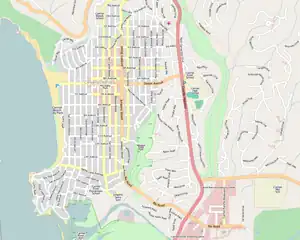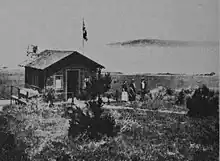| Wilson Building | |
|---|---|
| First City Hall Burchell House Building | |
.jpg.webp) Philip Wilson Building | |
| Location | 1770 Ocean Avenue, Carmel-by-the-Sea, California |
| Coordinates | 36°33′18″N 121°55′22″W / 36.55500°N 121.92278°W |
| Built | 1905 |
| Built for | Philip Wilson, Sr. |
| Original use | Real Estate Office |
| Current use | retail store |
| Architectural style(s) | Craftsman |
 Wilson Building Wilson Building | |
The Wilson Building, also known as the Philip Wilson Building is a historic commercial building in downtown Carmel-by-the-Sea, California. It is an example of American Craftsman architectural style that was built in 1905 on the corner of Ocean Avenue and Dolores Street as a real estate office. In 1916 it became Carmel’s first official City Hall. The building qualified as an important building in the city's downtown historic district property survey and was recorded with the California Register of Historical Resources on November 30, 2002.[1] The building is occupied by two tenants, the J. McLaughlin and The Agency.
History

The Wilson Building was established in 1905 by the Philip Wilson family as a real estate office during the pioneering days of Carmel-by-the-Sea, California. It is one of the oldest continually operating businesses in Carmel. The property is located on northwest corner of Ocean Avenue and Dolores Street.[1][2] The building became a gathering place for locals, including writer Jimmy Hopper in 1906.[3]
The Wilson Building is a two-story, rectangular wood frame building with a pitched shingled roof with two dormers. The ground floor has the original corner entrance. A doorway was added to the north of the building. The south and east sides of the building have horizontal redwood siding. In 1923, an addition was added to the north side of the building.[1]
The building served as Carmel's first "official" City Hall after its incorporation in 1916. A flagpole was erected on June 6, 1917. The monthly rent was $17.33 (equivalent to $353 in 2022).[4][5][6] It was also the location of Carmel’s first police department.[7]
In the 1990s, it was called the Burchell House Building. The Burchell House Properties (formerly Burchell Realty) held a grand opening of the restored property on October 1, 1999. The Burchell House Properties was a real-estate firm located in the upstairs office of the Wilson Building.[8]
The building qualified for inclusion in the city's Downtown Historic District Property Survey, and was registered with the California Register of Historical Resources on September 7, 2004. The building qualifies under the California Register criterion 3 in architecture, as a good example of early Craftsman style built for a commercial building in Carmel.[1]
Philip Wilson Jr.

Philip Wilson Jr. (1897-1959) was born in Ballinger, Texas on a cattle ranch. He moved to Carmel in 1905 with his family, one Carmel's' first residents. His parents were Scotsman Philip Wilson Sr. (1862-1944) and Laura May Pearce (1865-1962). His father was a rancher and his mother a public-school teacher. His mother was the sister of Mary Louise Pearce (1870-1952), who became Mrs. Dummage, wife of early plumber William T. Dummage (1854-1930) of Pacific Grove, California. See Mary Dummage Shop for details of her life. His sister, Grace Hood Wilson, married James H. Thorburn, who was the Carmel mayor from 1934-1936.[6][9]


His parents purchased several parcels along Ocean Avenue and Dolores Street in 1905 and opened a real estate office (now the Philip Wilson Building) at the Northwest corner of Ocean and Dolores. They built their home in 1906 on San Carlos Street opposite the Sunset School. In 1912, they purchased a home at 14th Avenue and San Antonio Street from writer John Fleming Wilson where they lived for 43 years. His father developed the first and only Carmel Golf Course, which was located south of Carmel Beach on Point Loeb (now called Carmel Point) near the mouth of the Carmel River. It was the second course on the Monterey Peninsula. The nine holes golf course was sold when Wilson Sr., went to service during World War I and the land was subdivided into lots. The clubhouse became a one bedroom residence.[1][3]
Wilson Jr. went to Monterey Union High School and served overseas in World War I. He acted in one of the first Forest Theater plays.[10][11] In 1924, he entered the real estate business that was established in Carmel by his father. He later opened a second real estate office in Carmel Valley. He and his wife Marion Robinson Bryant (1894-1971), owned the White Oak Inn in Carmel Valley (the historic milk house). In 1949, Maarion made it into the Carmel Valley Art Gallery.[1][12][13]
Wilson died on July 10, 1959, in Monterey, California due to a heart condition. Funeral services were held in the Little Chapel-by-the-Sea Crematorium. Rev. Don Johnson of the Carmel Valley Community Church officiated.[12]
See also
References
- 1 2 3 4 5 6 Richard N Janick (November 30, 2002). "Department Of Parks And Recreation" (PDF). National Park Service. Retrieved June 8, 2022.
- ↑ Dramov, Alissandra (2019). Historic Buildings of Downtown Carmel-by-the-Sea. Carmel-by-the-Sea, California: Arcadia Publishing. pp. 70–71, 2. ISBN 9781467103039. Retrieved 2022-06-08.
- 1 2 Hudson, Monica (2006). Carmel-By-The-Sea. Carmel-by-the-Sea, California: Arcadia Publishing. p. 44. ISBN 9780738531229. Retrieved 2022-06-09.
- ↑ "20 Years Ago". Carmel Pine Cone. Carmel-by-the-Sea, California. 1937-02-12. p. 11. Retrieved 2022-06-07.
- ↑ "Message From The Mayor". Carmel Pine Cone. Carmel-by-the-Sea, California. 1996-10-24. Retrieved 2022-06-08.
- 1 2 Hale, Sharron Lee (1980). A Tribute to Yesterday: The History of Carmel, Carmel Valley, Big Sur, Point Lobos, Carmelite Monastery, and Los Burros. Santa Cruz, California: Valley Publishers. pp. 57, 74, 96. ISBN 9780913548738. Retrieved 2022-06-08.
- ↑ Seavey, Kent (2007). Carmel, A History in Architecture. Carmel-by-the-Sea, California: Arcadia Publishing. p. 46. ISBN 9780738547053. Retrieved 2022-06-09.
- ↑ "Burchell House grand opening at Carmel's first city hall". Carmel Pine Cone. Carmel-by-the-Sea, California. 1999-10-01. p. 7. Retrieved 2022-06-09.
- ↑ Grimes, Teresa; Heumann, Leslie. "Historic Context Statement Carmel-by-the-Sea" (PDF). Leslie Heumann and Associates1994. pp. 15–16. Retrieved 2022-01-18.
- ↑ "Mrs. Wilson Celebrates Golden Anniversary Of Her Arrival in Carml". Carmel Pine Cone. Carmel-by-the-Sea, California. 1956-01-12. pp. 1, 3. Retrieved 2022-06-09.
- ↑ "Arts and Crafts Club Scrapbook". Harrison Memorial Library. Carmel-by-the-Sea, California. 1912. Retrieved 2022-06-09.
- 1 2 "Philip Wilson, Jr". Carmel Pine Cone. Carmel-by-the-Sea, California. 16 July 1959. p. 26. Retrieved 2022-05-09.
- ↑ "Carmel Valley's Historic White Oak Plaza" (PDF). Carmel Valley Historical Society. Carmel Valley, California. June 2020. p. 1. Retrieved February 20, 2023.